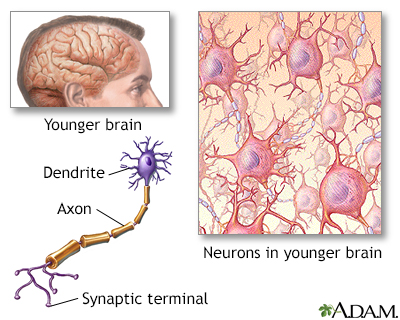Pregnancy SmartSiteTM
Tic - transient tic disorder DefinitionProvisional (transient) tic disorder is a condition in which a person makes one or many brief, repeated, movements or noises (tics). These movements or noises are involuntary (not on purpose). CausesProvisional tic disorder is common in children. The cause of provisional tic disorder can be physical or mental (psychological). It may be a mild form of Tourette syndrome. Provisional means that the tic has been present for less than a year. SymptomsYour child may have facial tics or tics involving movement of the arms, legs, or other areas. Tics may involve:
The tics often look like nervous behavior. Tics appear to get worse with stress. They may be less frequent during sleep or not occur during sleep at all. Sounds may also occur, such as:
Exams and TestsYour health care provider will consider physical causes of provisional tic disorder before making a diagnosis. In order to be diagnosed with provisional tic disorder, symptoms must be present less than one year and not be due to other conditions including use of substances. Other disorders such as anxiety, attention deficit hyperactivity disorder attention deficit hyperactivity disorder (ADHD), uncontrollable movement (myoclonus), obsessive-compulsive disorder (OCD), and epilepsy may need to be ruled out. TreatmentProviders recommend that family members do not call attention to the tics at first. This is because unwanted attention may make the tics worse. If the tics are severe enough to cause problems at school or work, behavioral techniques and medicines may help. Outlook (Prognosis)Simple childhood tics usually disappear over a period of months. If symptoms persist for more than three months, they are more likely to become chronic. Possible ComplicationsThere are usually no complications. A chronic motor tic disorder can develop. When to Contact a Medical ProfessionalTalk to your child's provider if you are concerned about a provisional tic disorder, especially if it continues or disrupts your child's life. If you are not sure whether the movements are a tic or a seizure, contact your provider right away. ReferencesKim JW, Walter HJ, DeMaso DR. Motor disorders and habits. In: Kliegman RM, St. Geme JW, Blum NJ, et al, eds. Nelson Textbook of Pediatrics. 22nd ed. Philadelphia, PA: Elsevier; 2025:chap 37. Singer HS, Mink JW, Gilbert DL, Jankovic J. Tics and tourette syndrome. In: Singer HS, Mink JW, Gilbert DL, Jankovic J, eds. Movement Disorders in Childhood. 3rd ed. Philadelphia, PA: Elsevier; 2022:chap 7. Tochen L, Singer HS. Tics and Tourette syndrome. In: Swaiman K, Ashwal S, Ferriero DM, et al, eds. Swaiman's Pediatric Neurology: Principles and Practice. 6th ed. Philadelphia, PA: Elsevier; 2017:chap 98. | |
| |
Review Date: 3/31/2024 Reviewed By: Joseph V. Campellone, MD, Department of Neurology, Cooper Medical School at Rowan University, Camden, NJ. Review provided by VeriMed Healthcare Network. Also reviewed by David C. Dugdale, MD, Medical Director, Brenda Conaway, Editorial Director, and the A.D.A.M. Editorial team. The information provided herein should not be used during any medical emergency or for the diagnosis or treatment of any medical condition. A licensed medical professional should be consulted for diagnosis and treatment of any and all medical conditions. Links to other sites are provided for information only -- they do not constitute endorsements of those other sites. No warranty of any kind, either expressed or implied, is made as to the accuracy, reliability, timeliness, or correctness of any translations made by a third-party service of the information provided herein into any other language. © 1997- A.D.A.M., a business unit of Ebix, Inc. Any duplication or distribution of the information contained herein is strictly prohibited. | |

 Central nervous sy...
Central nervous sy... Brain
Brain Brain and nervous ...
Brain and nervous ... Brain structures
Brain structures
